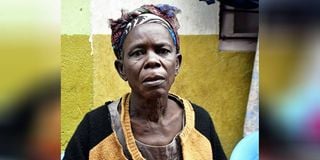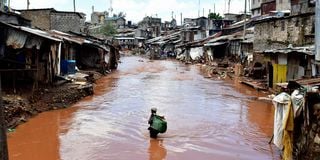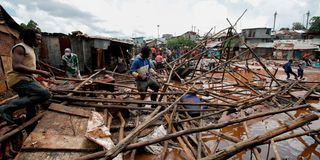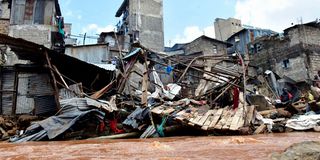Premium
A grandma’s night of horror after losing daughter, 3 grandchildren to floods

Salome Anyango gestures during the interview at her home in Mathare 4A area on May 8, 2024. She lost three members of her family in the recent floods.
What you need to know:
- Salome Anyango stayed by Mathare river from about 1am to six in the morning. She did not want to leave her other family members behind.
- “My heart was in pain. I was hoping to see my daughter, grandchildren, our good neighbour and her children," the granny says.
As football enthusiasts watched Arsenal unleash a torrent of goals against Chelsea on the night of April 23, a cloudburst descended on Nairobi, wreaking havoc on the poorly drained roads, flooding homes and sweeping away dozens of residents who live by river banks.
Caught in the unforgiving deluge was a grandmother who had travelled from Homa Bay County to stay at her daughter ’s house as she sought medical treatment in the capital.
The horror that Salome Anyango encountered that night as she fought to save her own life and those of her daughter, Jacinta Adhiambo, her grandchildren and a friendly neighbour she had just met left permanent physical and emotional scars.
So heavy was the downpour that the characteristic night sounds were silenced by the rain’s pitter-patter. With every drop of rain on the roofs of their corrugated iron sheet shacks, water kept rising, resulting in flooding that caught many families in Mathare slums by surprise.
Some rivers in the city and dams on the outskirts took in so much rainwater during the night that they spewed overflows that snaked their way to houses built in low-lying areas.
That night, Ms Anyango was with her daughter in her house in Mathare Area 4, together with her two grandchildren, Austin Ochieng’ and Jillvin Sherry.

Irine Akoth (right) gestures during the interview at her home in Mathare 4A area on May 08, 2024 where she spoke on how she lost her 10 year old son Austin Ochieng during the recent floods that swept away homes and properties. With her is her mother 60 year old Salome Anyango who lost three members of her family, a daughter and two grandchildren.
The Mathare River, one of the tributaries that form part of the Nairobi River basin, had always meandered by her daughter’s house, but never in her wildest imagination did she think that it would one day break its banks and become a merchant of death.
“The rain started pouring a few minutes after we went to bed. It was at around 11pm when we first saw water flowing into the house. None of us could sleep, so we sat on the bed. As the water kept rising, we decided to seek shelter in our neighbour’s house, which was on slightly higher ground,” Ms Anyango says.
The neighbour had two beds, she sat on one bed with her children while Ms Anyango, her daughter and grandchildren sat on the other. To their surprise, water kept rising.
“The more it rained, the higher the water rose. From the ankle, to the knee, to the waist. One of my grandchildren was so panicked that she asked me to take a table and put it on top of the bed so that we could all be safe,” she recounts. Even after they climbed on top of the table, the water kept swelling around them.
Ms Anyango started screaming with the hope that people would come to their rescue. It was in vain. She added prayers to her screaming.
She remembers seeing her neighbour taking her youngest child and carefully tying her on her back to keep her from the water.
As they rummaged around the semi-permanent house that was now flooded, a crack at a corner gave way to pressure and caved in. The other parts of the house soon followed, and that was the last time Ms Anyango saw the seven other people she was with in the house that night.
“Everything fell apart in that house. I saw trees falling down from outside. Stones that put the house together crumbled. The iron sheets were swept away. I got lost in the water while still in the ruined house. Most of the household items were blocking my way, and I couldn’t see an inch ahead of me,” Ms Anyanyo recounts.

A flooded Mathare River as it passes through Mathare Slums Gitathuru area on April 27, 2024.
Whenever her head rose above the water, she screamed for help.
“I couldn’t spot any house from where I was, all the houses were buried in water. It was as if I was in a big river. I got hold of a log that was part of a house and, that way, my head remained above water. I was too tired and cold. I felt a sharp cut on my right leg and it became numb for a minute. I felt relieved when I saw people coming my way,” she narrates.
She stayed by the river from about 1am to six in the morning. She did not want to leave her other family members behind.
“My heart was in pain. I was hoping to see my daughter, grandchildren, our good neighbour and her children. Onlookers surrounded me, one of them asked if I had any other relatives in Nairobi. Another gave me a sweater. I told them about my son and one of them contributed Sh50 for a motorbike ride to where my son stays in another part of the Mathare slum,” she recalls.
Her son, Charles Ombidi, remembers meeting his mother that morning on his way to his friend’s place.
“My mum was limping, and bleeding. I asked her why she came to my place barefoot that early. She didn’t respond. We walked to my house and since I could see how cold she was, the first thing I did was to prepare tea. When I was stepping out of the house to get an accompaniment for the tea, my mum told me what had happened. She thought I was going to my late sister’s place,” he says.

Residents sift through the rubble as they recover their belongings after the Nairobi River burst its banks and destroyed their homes within the Mathare valley in Nairobi, Kenya April 24, 2024.
Ms Anyango has still not been treated for the deep cut on her leg because the family cannot afford Sh100,000 surgery fee demanded by a local hospital. She is on painkillers and occasional dressing. Her tuberculosis drugs were swept away by the flood, but she got replacements at the local hospital.
By evening of the same day, only two bodies had been retrieved while the other five were retrieved days later.
Her only surviving daughter, Irene Okoth, who stays in Mombasa with her youngest child, lost her first child, Austin, who lived in Nairobi with her sister Jacinta. The young boy will be buried this Sunday in Homa Bay. Her daughter and granddaughter Sherry will be buried on Monday in Migori.
Ms Anyango’s pain is a representation of the statistics shared daily by the Kenya Red Cross of families who have lost their kin to the ongoing floods.
As of yesterday, the death toll from the floods across the country had hit to 257, and 188 people injured. A total of 293,661 had been affected and 54,837 households displaced as per a statement by the government spokesperson.
As episodes of torrential rains hit different parts of the world, major cities, including those that have never flooded before, have had devastating flooding.
A study published in the scientific journal Science Direct shows that extreme storms will continue to increase due to climate change.
“High intense rainfall events will adversely affect urban areas and induce more flooding happenstances,” states the study.
Nairobi, which is famously known as the green city in the sun, is now a city under water—at least in some parts.
But how did we get here?
Sylvester Kasuku, an urban planner who teaches at the University of Nairobi, says development master plans for the capital need urgent adjustments. He explains that the earliest Nairobi master plan was prepared in 1905, when the big dream was to make what is now the capital a railway town.
After that came the Settler Master Plan that was prepared in 1926 to 1927. About two decades later, a crucial spatial master plan was developed by Prof L.W Thornton White, an architect and town planner. In the post-colonial era, two master plans have since been drawn; one in 1973 called the Nairobi Metropolitan Growth Strategy, and the latest Project on Integrated Urban Development Master Plan for the City of Nairobi that was funded by JICA in 2014.
“Areas which were earmarked for industrial development were actually not done. Even developments like the bypasses were supposed to be developed much earlier than they were,” he says. “As such, when you undertake the development of a megacity, priming it for car transport or private car transport, you leave out a huge number of people.”
The don worries that the infrastructural developments that were to ensure the city is sustainable were not catered for.
“Beyond just the preparation of plans, beyond the implementation of plans, and beyond the provision for infrastructure and services for sustainable development, is the aspect of the development of land use, overtaking all the other developments that are required to make land use function or to make the city sustainable,” he says.
In 1948, when the first census was taken in Kenya, and Nairobi had a population of about 118,579. According to the 2019 Census, the city’s population is now about 4.4 million.
A study by Tomorrow Cities published in the Journal of Hydrology shows that the rapid population increase in the city and the informal settlements built on riparian land expose residents to a higher risk of floods.
“For example, in Kibera slums, more than 22,000 residents live along the banks of Ngong river ... and more than 50 per cent confirm their homes have been flooded in the recent past since 2015,” states the study. “It can be confirmed that floods are nowadays experienced in areas where the occurrence was rather infrequent two decades ago in the city.”
When it rains, stormwater usually has its natural pathways which flow through gravity. However, the scientists explain that urban flooding is caused when stormwater overwhelms an existing drainage system and it becomes even worse when they are blocked or the waterways diverted.
The study shows that in developing cities such as Nairobi, fluvial floods (caused when the rivers overflow) are less common but cannot be ruled out since several riverine tributaries meander through the city downstream.
“The developing cities and mostly the informal settlement are the major hotspots of pluvial flooding (caused by excess run-off water that is not necessarily linked to water bodies), which pose a threat to the fundamental steps to the achievement of sustainable development goals,” explains the Journal of Hydrology study.
While it is apparent that cities around the world are flood-prone, there exist few flood hazard modelling studies, especially in Africa.
“This has led to inadequate informal settlement targeted and evidence-based flood risk management measures and policies in most developing cities in cases where they do exist. This implies less evidence to support targeted integrated flood risk management in the informal settlements,” explains the researchers.
The scientists also explain that the hydrodynamics (motion of liquids) of the urban torrents undergo a series of interferences due to the complex nature of the urban setups and thus pose a significant challenge to parameterising most of the factors for studies.
"Nairobi is a gentle topography. The floods that we are getting are mostly a result of the rivers bursting their banks. Construction is also a major cause because there is no infiltration of water since we mostly have pavements or tarmacked roads. There is a lot of run-off, and this explains why cities around the world are flooding," David Adede, a Geologist, explains.
He says that floods can be mitigated by simply making way for water since if we don't, it will find its way; as well as planting trees and artificially raising banks.
Nasra Nanda, a member of County Assembly of Nairobi, who is also the chair of a special sub-committee for planning, says the flooding in the city is a historical problem exposing poor planning that has not been compliant with the laws.

People affected by floods wait for humanitarian aid at Valley Bridge Primary School in Kiamaiko, Mathare on Sunday April 28.
“There have been unplanned developments across the city, including buildings put up on riparian land. So, over time, this creates an urban sprawl that is not resilient when it comes to any adverse impacts of climate change,” she says, adding that the city also has a waste management problem.
“One of the things I proposed to the rescue team was having evacuation efforts because the people need temporary shelter. My proposal also includes CashforShelter where those affected are given rent, let’s say for up to three months so that they can find safer areas to stay,” she explains.
Nasra says that it is time we reclaim our cities by having sustainable public spaces.
“What Nairobi lacks is the urban forest cover, because that then creates the necessary shocks that concrete spaces have taken away from us. As legislators we need to oversee how approvals of buildings are done,” she says.
In both Nairobi and Mombasa city, just as is in Dubai, Dar es Salaam, some parts of Brazil and other cities that have flooded recently she says that there needs to be a re-definition of what posh is.

A flooded Mathare River as it passes through Mathare Slums Gitathuru area on April 27, 2024.
“Posh should mean a more resilient space in Nairobi and that has exposed a lot of spaces but what has been overlooked is their resilience,” says Nasra.
But why is the situation so dire this time?
The torrents are happening at a time when Kenya typically experiences long rains between March, April and May.
Both the Kenya Meteorological Organisation and the IGAD Climate Prediction and Applications Centre (ICPAC) announced that this period will have above-average rainfall.
In an interview with the Nation, ICPAC’s director Dr Guleid Artan says that the ongoing rains are influenced by the positive phase of ENSO (El Niño-Southern Oscillation).
Dr Joyce Kimutai, climate scientist and meteorologist who also co-authors the World Weather Attribution report explains that the sea surface temperature of the Pacific Ocean influences either an El Nino or La Nina phenomena.
Our neighbouring ocean, the Indian Ocean also plays a part in telling whether there is an El Nino phase characterised by what scientists call a positive Indian Ocean Dipole.
“The flooding that we see in Eastern Africa or the extreme rainfall we see in Eastern Africa is because our atmosphere is continuing to warm,” she says.
She says that last year, we hit 1.45 degrees Celsius above the pre-industrial levels, just a few degrees shy of reaching the dreaded 1.5 degrees Celsius that was capped under the Paris Agreement.
“What climate change is doing is that it's making it (El Nino) intense, and it's also making it a bit recurrent. So you find that El Ninos have become very recurrent, and they've become very strong,” she says.
An update from the World Meteorological Organisation (WMO) in March showed that there was a 60 per cent chance that the condition would persist through to May and an 80 per cent chance of having neutral conditions between April and June. The WMO cited that the ongoing El Nino is one of the five strongest on record.
“We're likely to see more of this flooding. So then that means we have to really prepare better and we have to see how our drainage systems are. We have to listen to scientists because they are trained in that field,” Dr Kimutai says, also warning about littering.
Apart from people not being environmentally conscious, she advises that regulators like the National Environment Management Authority to be strict on enforcing riparian laws.
Prof Alfred Opere, an associate professor of climate, water resources and hydrological modelling at the University of Nairobi, explains that we all have a part to play in our environment, but government preparedness was below par.

Collapsed houses in Mathare Slums' Gitathuru area on April 27, 2024.
“These current rains were projected, but people still don’t want to believe that the Met department’s skill of forecasting has improved over the years. So they dismiss what is said,” he says.
“The drainage systems needed to have been given the capacity to allow water to flow through them.”
He advises that cities need more places like the water recreational area at Uhuru Park which helps in controlling floods.
“Climate change is here with us and is likely to stay with us, what we need to do is to review structures that were constructed in the yesteryears to be in tandem with the fact that things will never be the same again,” he explains.





